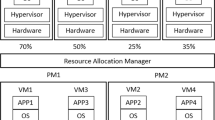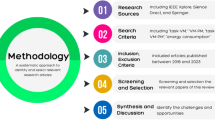Abstract
Nowadays, mobile devices are becoming the most popular computing device as their computing capabilities increase rapidly. However, it is still challenging to execute highly sophisticated applications such as 3D video games on mobile devices due to its constrained key computational resources. Execution offloading approaches have been proposed to resolve this problem by strengthening mobile devices with powerful cloud. Unfortunately, the existing offloading approaches are not suitable for 3D video games because of the unique execution characteristics of them. In this paper, we propose a streaming-based execution offloading framework to enable execution offloading for 3D video games. The experiments show that our framework successfully guarantees 20 frames per second for our benchmark.







Similar content being viewed by others
Notes
In Java language, a method is the equivalent of a function in languages like C.
References
Christou G (2013) A comparison between experienced and inexperienced video game players’ perceptions. HCIS 3:1–15
Chun B-G, Ihm S, Maniatis P, Naik M, Patti A (2011) CloneCloud: elastic execution between mobile device and cloud, Proceedings of the sixth conference on Computer systems. ACM, pp 301–314
Cuervo E, Balasubramanian A, Cho D-k, Wolman A, Saroiu S, Chandra R, Bahl P (2010) MAUI: making smartphones last longer with code offload. In: Proceedings of the 8th international conference on mobile systems, applications, and services. ACM, pp 49–62
Gartner (2013) Gartner says worldwide video game market to total $93 billion in 2013. http://www.gartner.com/newsroom/id/2614915
Gordon MS, Jamshidi DA, Mahlke S, Mao ZM, Chen X (2012) COMET: code offload by migrating execution transparently. In: Proceedings of the 10th USENIX conference on operating systems design and implementation, Berkeley, pp 93–106
Gu X, Nahrstedt K, Messer A, Greenberg I, Milojicic D (2003) Adaptive offloading inference for delivering applications in pervasive computing environments. In: Proceedings of the first IEEE international conference on pervasive computing and communications, (PerCom 2003), pp 107–114
Kosta S, Aucinas A, Hui P, Mortier R, Zhang X (2012) ThinkAir: dynamic resource allocation and parallel execution in the cloud for mobile code offloading. INFOCOM, Proceedings IEEE, pp 945–953
Kovachev D, Yu T, Klamma R (2012) Adaptive computation offloading from mobile devices into the cloud. In: 2012 IEEE 10th international symposium on parallel and distributed processing with applications (ISPA), pp 784–791
libGDX [Online], http://libgdx.badlogicgames.com/
Monsoon power monitor [Online], http://www.msoon.com/
Newton R, Toledo S, Girod L, Balakrishnan H, Madden S (2009) Wishbone: profile-based partitioning for sensornet applications. In: USENIX symposium on networked systems design and implementation, vol 9, pp 395–408
Ra M-R, Sheth A, Mummert L, Pillai P, Wetherall D, Govindan R (2011) Odessa: enabling interactive perception applications on mobile devices. In: Proceedings of the 9th international conference on mobile systems, applications, and services, pp 43–56
Satyanarayanan M, Gilbert B, Toups M, Tolia N, Surie A, O’Hallaron DR, Wolbach A, Harkes J, Perrig A, Farber DJ, Kozuch MA, Helfrich CJ, Nath P, Lagar-Cavilla HA (2007) Pervasive personal computing in an internet suspend/resume system. IEEE Internet Comput 11(2):16–25
Satyanarayanan M, Bahl P, Caceres R, Davies N (2009) The case for VM-based cloudlets in mobile computing. IEEE Pervasive Comput 8(4):14–23
Sharma R, Nitin (2014) Duplication with task assignment in mesh distributed system. JIPS 10,(2):193–214
Wang S, Dey S (2009) Modeling and characterizing user experience in a cloud server based mobile gaming approach. Global Telecommunications Conference, 2009. GLOBECOM 2009 IEEE. IEEE, pp 1–7
Wang S, Dey S (2010) Rendering adaptation to address communication and computation constraints in cloud mobile gaming. Global Telecommunications Conference (GLOBECOM 2010), 2010 IEEE, pp 1–6
Yang S, Kwon Y, Cho Y, Yi H, Kwon D, Youn J, Paek Y (2013) Fast dynamic execution offloading for efficient mobile cloud computing. In: 2013 IEEE international conference on pervasive computing and communications (PerCom), Los Alamitos, pp 20–28.
Yang S, Kwon D, Yi H, Cho Y, Kwon Y, Paek Y (2014) Techniques to minimize state transfer costs for dynamic execution offloading in mobile cloud computing. IEEE Trans Mob Comput 13(11):2648–2660
Acknowledgments
This work was partly supported by the National Research Foundation of Korea (NRF) grant funded by the Korea government (MSIP) (No. 2014R1A2A1A10051792), IDEC, the Brain Korea 21 Plus Project in 2016, Inter-University Semiconductor Research Center(ISRC) and Institute of Computer Technology(ICT) at Seoul National University.
Author information
Authors and Affiliations
Corresponding authors
Rights and permissions
About this article
Cite this article
Kwon, D., Yang, S., Paek, Y. et al. Optimization techniques to enable execution offloading for 3D video games. Multimed Tools Appl 76, 11347–11360 (2017). https://doi.org/10.1007/s11042-016-3711-9
Received:
Revised:
Accepted:
Published:
Issue Date:
DOI: https://doi.org/10.1007/s11042-016-3711-9




